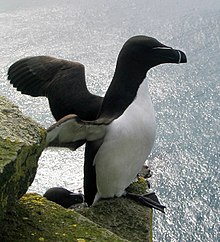| Pan-Alcidae Temporal range: Late Eocene - Recent 35–0 Ma PreꞒ Ꞓ O S D C P T J K Pg N | |
|---|---|

| |
| Razorbill Alca torda | |
| Scientific classification | |
| Domain: | Eukaryota |
| Kingdom: | Animalia |
| Phylum: | Chordata |
| Class: | Aves |
| Order: | Charadriiformes |
| Suborder: | Lari |
| Clade: | Pan-Alcidae Smith, 2011 |
| Subgroups | |
Pan-Alcidae is a clade of charadriiform birds containing the auks and their extinct relatives. It was named in 2011 by N.A. Smith, who defined it as all descendants of the common ancestor of the group Mancallinae and crown group auks (Alcidae), but some have disputed the use of the Pan- prefix in general for family-group names regulated by the Zoocode (ICZN Code).
Evolution and distribution
The earliest unequivocal fossils of pan-alcids are from the late Eocene, some 35 mya. The genus Miocepphus, (from the Miocene, 15 mya) is the earliest known from associated specimens. Two Paleogene fossils were previously assigned to the Alcidae, but have since been removed to other clades: Hydrotherikornis (late Eocene) is a procellariiform and Petralca (Late Oligocene) is a loon. Most extant genera are known to exist since the Late Miocene or Early Pliocene (c. 5 may). Miocene fossils have been found in both California and Maryland, but the greater diversity of fossils and tribes in the Pacific leads most scientists to conclude that it was there they first evolved, and it is in the Miocene Pacific that the first fossils of extant genera are found. Early movement between the Pacific and the Atlantic probably happened to the south (since there was no northern opening to the Atlantic), later movements across the Arctic Ocean. The flightless clade Mancallinae was present in the eastern and western Pacific Ocean and became extinct in the Late Pleistocene.
References
- ^ Smith, N.A. (2011). "Taxonomic revision and phylogenetic analysis of the flightless Mancallinae (Aves, Pan-Alcidae)". ZooKeys (91): 1–116. Bibcode:2011ZooK...91....1S. doi:10.3897/zookeys.91.709. PMC 3084493. PMID 21594108.
- Louchart, A., Viriot, L. & Dubois, A. (2013): The use of the prefix Pan- and other problems in zoological family-series nomenclature. Zootaxa 3750 (2): 197-200. doi: 10.11646/zootaxa.3750.2.9
- ^ Mayr, G. (2009). Paleogene Fossil Birds.
- Olson and Rasmussen (2001). "Miocene and Pliocene Birds from the Lee Creek Mine". North Carolina. Smithsonian Contributions to Paleobiology. 91: 233–365. doi:10.5479/si.00810266.90.233.
- Konyukhov (2002) Possible ways of spreading and evolution in the alcids. Biology Bulletin 29:447-454.